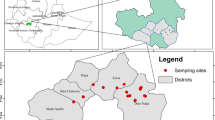Abstract
Influences of agricultural practices on water quality of the Tumbling Creek cave stream are of particular interest because of the karst nature of the area and the recent implementation of a Better Management Practice (BMP). Water quality parameters, measured bi-weekly during one year, consisted of pH, turbidity, water temperature, specific conductivity, total dissolved solids, alkalinity, and chloride. Heavy metals, nutrient and bacteria levels were also monitored during the study. Effects of land use were most obvious in turbidity, nitrate, chloride, and bacteria levels. Sites within the recharge area that pose a major threat to its water quality were identified. Results provide a baseline for these water quality parameters and their seasonal variability that can be used in future studies to address the effects of water quality and stream sediment contamination on the cave’s ecosystem and to determine the effectiveness of the BMP implemented in this karst area.







Similar content being viewed by others
References
Aley T (1972) Groundwater contamination from sinkhole dumps. Caves and Karst 14:17–23
APHA (1995) Standard methods for the examination of water and wastewater. American Public Health Association, Washington, DC
Berryhill WS (1989) The impact of agricultural practices on water quality in karst regions. In: Beck BF (ed) Engineering and environmental impacts of sinkholes and karst. Balkema, Rotterdam, pp 159–164
Boyer D (1993) Scientists go underground to check water quality. Agr Res August:4–8
Canter LW (1997) Nitrates in groundwater. Lewis, New York, pp 6–8
Currens JC (2002) Changes in groundwater quality in a conduit-flow-dominated karst aquifer, following BMP implementation. Environ Geol 42(5):525–531
Doran JE, Linn DM (1979) Bacteriological quality of runoff water from pastureland. Appl Environ Microbiol 37:985–991
DNR Missouri Department of Natural Resources (2000) Rules of Department of Natural Resources, Division 20-Clean Water Commission, http://www.epa.gov/waterscience/standards/wqslibrary/mo/mo_7_wqs.pdf
EPA (1999) National recommended water quality criteria-correction. EPA 822-Z-99–001, April 1999, pp 1–25
Forstner U, Wittmann GTW (1981) Metal pollution in the aquatic environment. Springer, Berlin Heidelberg New York, pp 1–486
Greenlee RE (1974) Biological investigations at Ozark Underground Laboratory. Missouri Speleology 14(3):8–11
Hallberg GR (1986) From hoes to herbicides: agricultural and groundwater quality. Soil Water Conserv 41:357–364
Hess JW, White WB (1988) Storm response of the karstic carbonate aquifer of south central Kentucky. Hydrology 99:235–252
Hoke JA, Wicks CM (1997) Contaminant transport in karst aquifers, the engineering geology and hydrogeology of karst terrains. Balkema, Rotterdam, pp 189–192
Hubricht L (1971) New Hydrobiidae from Ozark caves. Nautilus 84(3):93–96
Kastrinos JR, White WB (1986) Seasonal, hydrogeologic, and land use controls on nitrate contamination of carbonate groundwater. Proceedings environmental problems in karst terranes and their solutions. National Water Well Associations, Dublin, Ohio, pp 88–112
Lory JA (1999) Agricultural phosphorus and water quality. MU-Agricultural, G9181 April 1999, pp 1–7
Martin HW, Harris WG (1992) Mineralogy of clay sediments in three phreatic caves of the Suwannee River basin. NSS Bulletin 54(2):69–76
Neill H (2003) Effect of land use on Tumbling Creek Cave in Taney County, Missouri. MSc Thesis, Southwest Missouri State University, 98 pp
Pasquarell GC, Boyer DG (1995) Agricultural impacts on bacterial water quality in karst groundwater. Environ Qual 24:959–969
Richards R, Baker D, Kramer J, Ewing D, Merryfield B, Miller N (2001) Storm discharge, loads, and average concentrations in northwest Ohio rivers, 1975–1995. JAWRA 37(2):423–438
Rose T (2003) Coliforms, Salmonella, and Shigella in the James River Basin. MSc Thesis, Southwest Missouri State University, 122 pp
Thomson KC (1971) Ozark Underground Laboratory part 1. Ozark Caver 3(5):1–25
USDA (1990) Soil Survey of Taney County, Missouri. USDA/NRCS
USGS (1996) Nitrate high in agricultural wells: USGS samples groundwater. Water Environ Technol 1996:38
Ward AD, Elliot WJ (1995) Environmental hydrology. Lewis, New York, 462 pp
White WB (1988) Geomorphology and hydrology of karst terrains. Oxford University Press, New York
Acknowledgments
The authors would like to thank Ozark Underground Laboratory staff for their assistance throughout this study, Dr. R. Cammack for guidance with GIS and Dr. Biagoni for assistance with chemical analysis. Gratitude is extended to the Watershed Committee of the Ozarks and Steve VanRhein for use of laboratory equipment and guidance. Funding for this project was provided by Southwest Missouri State University Graduate College and the GK-12 Teaching Fellows National Science Foundation grant.
Author information
Authors and Affiliations
Corresponding author
Rights and permissions
About this article
Cite this article
Neill, H., Gutiérrez, M. & Aley, T. Influences of agricultural practices on water quality of Tumbling Creek cave stream in Taney County, Missouri. Env Geol 45, 550–559 (2004). https://doi.org/10.1007/s00254-003-0910-2
Received:
Accepted:
Published:
Issue Date:
DOI: https://doi.org/10.1007/s00254-003-0910-2




